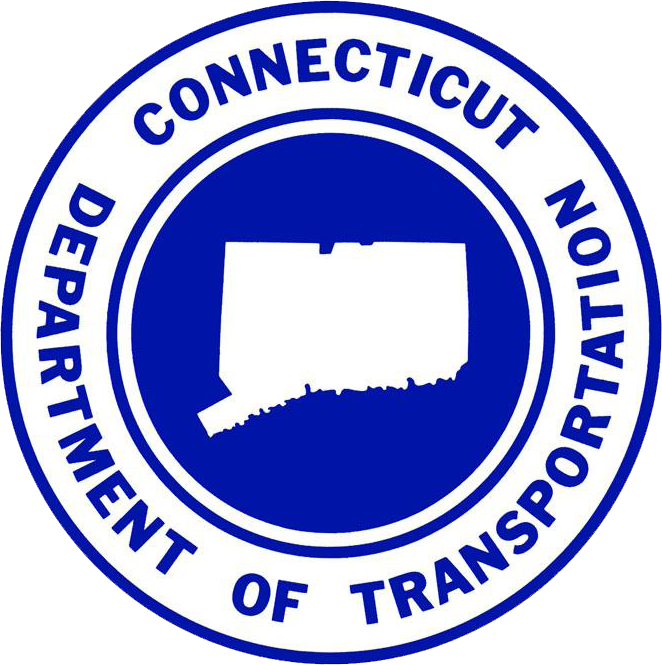A Brief History of Transportation in Hartford
Historically a river port city, Hartford traded goods with farming villages up and down the Connecticut River Valley. Travel the timeline below to see how the City of Hartford has been defined and shaped by transportation over the years.

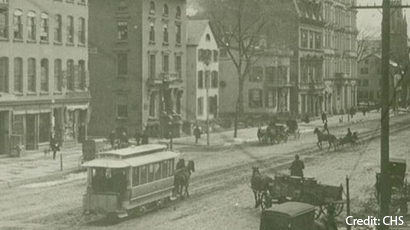
Transit Improvements over the 1800s
In the 1820s, many people traveled by horse-drawn buses; in the 1830s, steam buses were employed, followed by electric trolley buses in the 1880s.
Title
Content

Content

About text
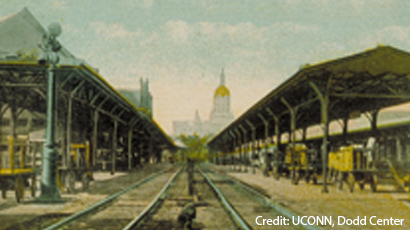
1843
Hartford's Union Station was built at its first location on Asylum Street. It was first called "Union Depot." Construction on the current building was completed in 1889.
Title
Content

Content

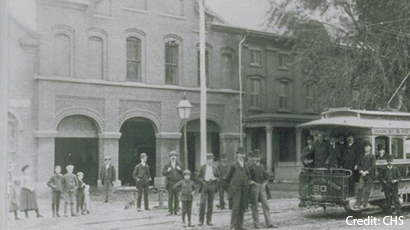
Early 1860s
Street railways, rails laid down in city streets, became common and were more efficient for transporting travelers than previously used omnibuses, horse-drawn enclosed buses. Ten to twelve passengers could board an omnibus, while 75 people could travel in a street rail car. On July 29, 1871, the first ceremonial train traveled along a new 44-mile track built by the Connecticut Valley Railroad.
Title
Content

Content

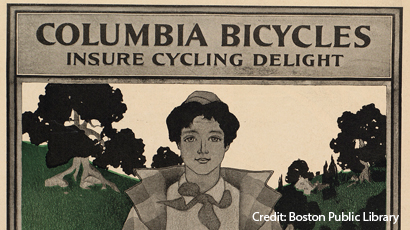
1878
America's first bicycles, Columbia Bicycles, were made in 1878 on Capitol Avenue in Hartford by Pope Manufacturing Company--very close to where I-84 passes today. Later the price ($125/bike), and the wheel size came down to make bicycles a safer, more affordable means of transportation.
Title
Content

Content

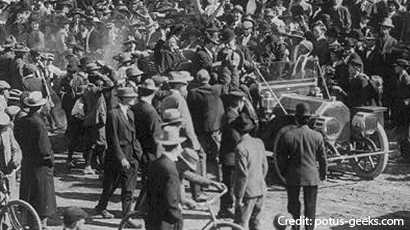
1902
President Theodore Roosevelt took the first presidential motorcade in Hartford on August 22, 1902. He rode in a Columbia Electric Victoria Phaeton, which had a maximum speed of 13 miles per hour. Police guards rode on bicycles because they could not walk fast enough to keep up. The Columbia Car, which was an all electric vehicle, was produced in the same factory as the bicycle. It was the largest producer of cars in the U.S. at the time.
Title
Content

Content

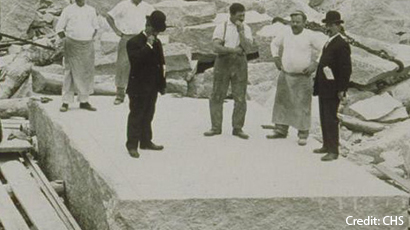
1908
The Bulkeley Bridge was built, named after former Hartford Mayor Morgan B. Bulkeley. It now carries Interstate 84 (I-84) across the Connecticut River. Travelers were originally charged a toll to cross it. The bridge was built to replace Hartford's 1818 covered bridge, which caught fire in 1895. Hartford's civic and business leaders were determined that the new bridge would be "an ornament to the city which should endure forever."
Title
Content

Content

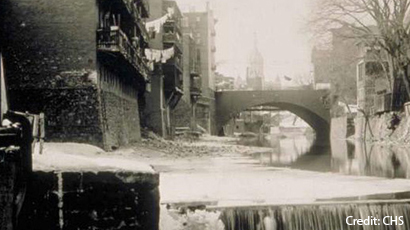
1940
The Army Corps of Engineers buried the Park River, also known as the "Hog River" to prevent flooding. Local businesses and factories put their waste into the river, and it quickly became a carrier of waterborne illnesses during the summer. The river was confined in two tubes made of concrete and was 5,800 feet long flowing from the Connecticut River to the space between The Capitol and the Armory buildings in Hartford. It was later extended to the west during the construction of I-84 in the 1960s.
Title
Content

Content

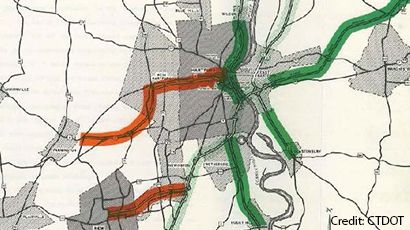
1945
The Connecticut Highway Department published a report of an engineering study for Expressways in the Hartford Metropolitan Area. The report presented a general plan for an east-west expressway from Hartford to the western suburbs. It was quoted in the report that "The major element in any plan to bring order into what has been a wasteful trend is to provide relief to the intolerable traffic congestion."
Title
Content

Content

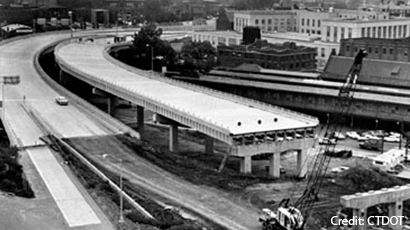
1956
The Federal Aid Highway Act was passed in 1956, and the East-West Expressway was incorporated into the Interstate Highway System as I-84.
Title
Content

Content

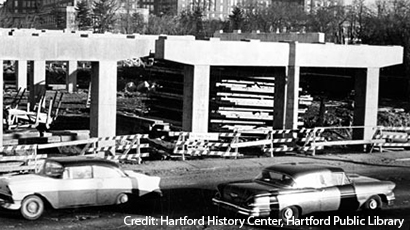
1960s
The construction of I-84 in Hartford began in 1959. It was completed in 1969. The alignment grew from various 1940s and 1950s studies of the East-West Expressway, a freeway meant to relieve congestion on local streets and to provide fast and efficient travel between the west and southwest and the central business district of Hartford. Within Hartford the highway corridor plan generally followed the corridor of the railroad and the Park River. In 1964, the Bulkeley Bridge was widened to eight lanes.
Title
Content

Content

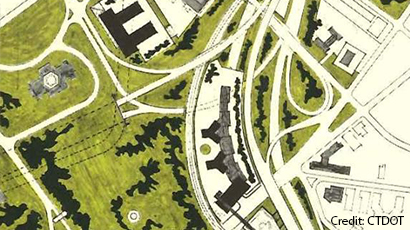
1970
The CT Department of Transportation, FHWA, and The City of Hartford, determined that aside from relieving traffic congestion, the visual aspects of I-84 had the most profound environmental impact on the city. The highway was described as imposing.
Title
Content

Content


1970
Congress passed the Rail Passenger Service Act of 1970. This legislation established the National Railroad Passenger Corporation to take over the intercity passenger rail service that had been operated by private railroads. Amtrak began service on May 1, 1971, serving 43 states with a total of 21 routes, including service to Hartford.
Title
Content

Content

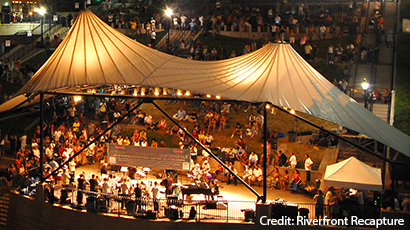
1980s-1990s
The I-84/I-91 interchange, I-91, and the Founders Bridge were reconstructed to improve interstate connections and allow access to the Connecticut River. The $200+ million project was completed in 1998. A direct flyover ramp opened 80 feet above Morgan Street to provide access from eastbound I-84 to northbound I-91.
Title
Content

Content

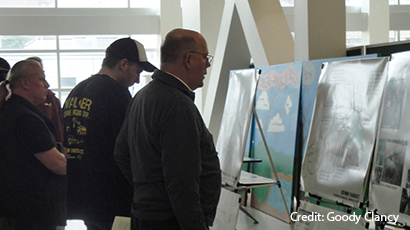
2006
The mayor of Hartford assigned The HUB of Hartford Committee to discuss rehabilitating I-84. This study aims to research ways to repair the viaduct. Transportation is at the forefront of the study exploring the impacts on the urban environment and the quality of life for the residents of Hartford.
Title
Content

Content

Title
Content

Content






